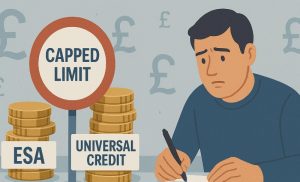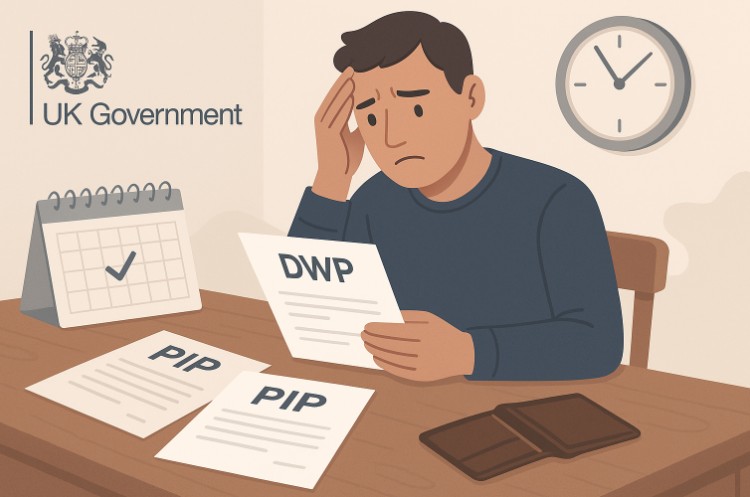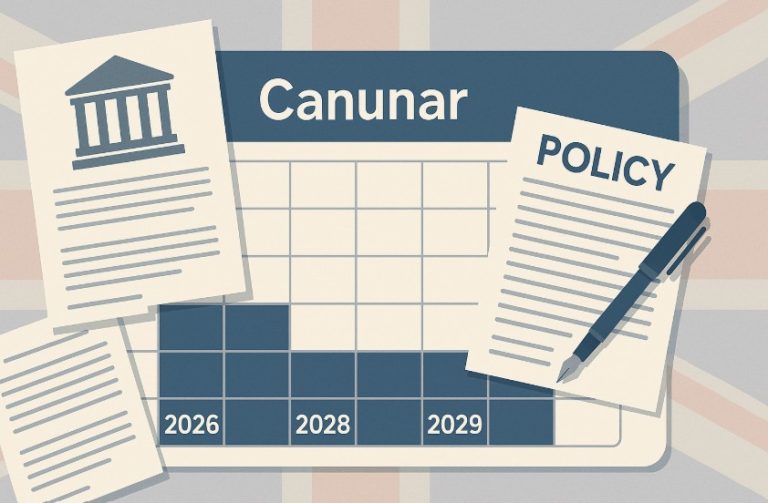Understanding the UK benefits system can be confusing, especially when it comes to claiming more than one type of support.
A common question asked by many people who are ill, disabled or out of work is: can you get ESA (Employment and Support Allowance) and Universal Credit at the same time? The answer is yes, but with specific conditions that must be met.
Let’s break down exactly how these benefits interact and what you need to know if you’re planning to claim both.
What Is ESA and How Does It Work in the UK?

Employment and Support Allowance (ESA) is a financial benefit offered to individuals who are unable to work due to illness or disability. There are two primary types of ESA:
- New Style ESA: A contribution-based benefit dependent on the claimant’s National Insurance (NI) contributions during the two full tax years before the claim year.
- Income-related ESA: A legacy benefit replaced by Universal Credit and no longer available to new applicants.
Only New Style ESA can be claimed alongside Universal Credit. This benefit is not means-tested, meaning savings or household income do not affect entitlement. However, applicants must meet contribution conditions.
There are two main payment phases of New Style ESA:
Assessment Phase (First 13 Weeks):
- Individuals aged 18 to 24 can receive up to £72.90 per week.
- Individuals aged 25 and over can receive up to £92.05 per week.
Main Phase (Post Assessment):
If the claimant is found to have limited capability for work, they move into the main phase and may receive additional components.
| Category | Weekly Amount |
| Basic allowance (standard rate) | Up to £92.05 |
| Support component (if applicable) | £48.50 |
New Style ESA is paid fortnightly into the claimant’s nominated bank, building society or credit union account. It’s important to note that individuals cannot receive ESA at the same time as Statutory Sick Pay (SSP), though they can apply for ESA up to three months before SSP ends.
What Is Universal Credit and How Much Can Claim It?
Universal Credit is a monthly payment aimed at supporting individuals who are on a low income or out of work. It replaces several older benefits, including Housing Benefit, Child Tax Credit, and Income-based Jobseeker’s Allowance.
Eligibility is determined by several factors including:
- Overall household income
- Savings and capital (savings over £6,000 reduce the amount; over £16,000 disqualifies)
- Employment status
- Household composition
Universal Credit includes various elements such as housing support, child elements, limited capability for work payments, and carer elements.
People who are ill or disabled can receive additional financial support, depending on the outcome of a Work Capability Assessment.
The amount you receive in Universal Credit depends on your circumstances. Every household receives a standard allowance, with additional amounts added if you meet specific eligibility criteria.
The standard monthly allowance ranges from £316.98 for single claimants under 25 to £628.10 for couples where one or both partners are over 25.
You may receive extra monthly amounts for children, disabilities, caring responsibilities, or housing costs. For example:
- You can receive up to £339 for your first child (if born before 6 April 2017) or £292.81 per eligible child thereafter.
- If your child has a disability, you may receive £158.76 or £495.87 depending on the severity.
- If you have limited capability for work and work-related activity, an additional £423.27 may apply.
- Carers providing 35+ hours of care per week could receive an extra £201.68.
Universal Credit also covers up to 85% of registered childcare costs, capped at £1,031.88 for one child and £1,768.94 for two or more.
However, deductions may apply if you’re repaying debts, have savings over £6,000, or receive other benefits such as ESA or Carer’s Allowance. Each deduction reduces your final payment.
Can You Claim Both ESA and Universal Credit Together?

Claimants who meet the eligibility requirements can claim both New Style ESA and Universal Credit at the same time. However, it is essential to understand how these benefits interact.
New Style ESA is not means-tested, so eligibility is based on the applicant’s NI contribution history. Universal Credit, on the other hand, is means-tested and considers household income and capital.
If both claims are successful, the ESA payments will be deducted from the Universal Credit award. This prevents the duplication of financial support for the same living needs.
How Are ESA Payments Offset Against Universal Credit?
When a person claims both benefits, any amount received through New Style ESA is directly deducted from their monthly Universal Credit entitlement. This process ensures that claimants are not overpaid or double-funded.
| Scenario | Amount (£) |
| Universal Credit entitlement | 800 |
| New Style ESA received | 100 |
| Adjusted Universal Credit payment | 700 |
Even though the total amount remains the same, receiving New Style ESA provides fortnightly payments, which may offer better cash flow management for some claimants.
What Are the Advantages of Claiming ESA Alongside Universal Credit?
Claiming both New Style ESA and Universal Credit can offer several practical and financial advantages, especially for individuals with health conditions or disabilities.
While Universal Credit payments are reduced by the amount you receive in ESA, receiving both benefits simultaneously still provides several important benefits.
Fortnightly Payments Provide More Frequent Financial Support
New Style ESA is paid every two weeks, unlike Universal Credit which is paid monthly. This means you receive a portion of your benefit income more regularly, which can help with managing essential living costs such as food, transport, and utilities.
The more frequent cash flow may be particularly helpful for those who find it difficult to stretch a single monthly payment over four weeks.
National Insurance Credits Help Secure Your Future Entitlements
Receiving ESA entitles you to National Insurance credits, which count towards your State Pension and may affect your eligibility for other contribution-based benefits in the future.
Even if your income is low or you’re unable to work for an extended period due to illness, these credits help maintain your National Insurance record without the need to make actual contributions.
Specialised Health Support Tailored to Your Needs
ESA is specifically designed to support people with health conditions that affect their ability to work. If you are assessed as having limited capability for work or work-related activity, you may be placed into the ESA support group.
This means you’re not expected to look for work and may receive additional financial support.
Unlike Universal Credit, ESA has a distinct structure that focuses more intensively on medical needs, making it a valuable complement for those facing long-term or complex health issues.
No Impact from Savings or Household Income on ESA Eligibility
New Style ESA is not means-tested, which means your savings or your partner’s income will not affect your eligibility or payment amount.
This differs from Universal Credit, where income and capital can significantly reduce your entitlement or make you ineligible altogether.
For those who may not qualify for full Universal Credit due to savings or a working partner, ESA can still provide crucial financial assistance.
Streamlined Medical Assessment for Both Benefits
When claiming both ESA and Universal Credit, you will only be required to attend one Work Capability Assessment.
This single medical evaluation determines your eligibility for both benefits, reducing duplication and administrative burden.
This streamlining also ensures that your health condition is consistently assessed across the two benefits, making it easier to manage the process and reducing the stress of repeated appointments.
Potential for Enhanced Financial Stability During Illness
By combining ESA’s regular, contribution-based support with Universal Credit’s broader means-tested coverage, claimants can create a more stable and flexible safety net.
This approach helps ensure that individuals with long-term health issues receive continuous and reliable financial support without depending on just one benefit source.
Will You Need a Work Capability Assessment for Both Benefits?

Claimants applying for both ESA and Universal Credit will only undergo one Work Capability Assessment (WCA). The Department for Work and Pensions (DWP) uses the result of this single assessment to determine eligibility for both benefits.
The WCA classifies individuals into one of three categories:
- Fit for work
- Limited capability for work
- Limited capability for work and work-related activity (support group)
The assessment is carried out by a healthcare professional appointed by the DWP. Depending on the outcome, additional support elements may be added to Universal Credit and/or ESA.
What Should You Know Before Applying for Both Benefits?
Before proceeding with both applications, claimants should ensure they meet the following criteria:
- National Insurance record: Sufficient contributions in the relevant tax years are required for ESA.
- Income and savings: These are considered for Universal Credit but not for ESA.
- Health documentation: Fit notes and medical evidence should be up-to-date and clearly outline limitations on work capability.
- Application timing: ESA applications can be made while receiving SSP but payments start only once SSP ends.
The application process for both benefits is separate. Claimants must apply for ESA and Universal Credit individually through the GOV.UK website or by contacting the Jobcentre.
Can You Still Receive the Severe Disability Premium on ESA?
Claimants who were previously receiving income-related ESA may have also received the Severe Disability Premium (SDP). However, New Style ESA does not include this component.
Universal Credit does not include an SDP equivalent, but transitional payments may be available for some individuals moving from legacy benefits.
Claimants should be cautious when switching from income-related ESA to Universal Credit, especially if they currently receive SDP, as the total award may decrease without transitional protection.
How Do You Apply for ESA and Universal Credit Simultaneously?
The process involves completing two separate applications:
- Apply for Universal Credit via the GOV.UK website. This involves creating an online account, providing identity verification, and completing household income and circumstance details.
- Apply for New Style ESA through a separate GOV.UK application form or by calling the ESA helpline. Claimants must provide National Insurance details, medical certification, and employment history.
After submitting both applications:
- Inform the Jobcentre during your Universal Credit interview that you are also claiming ESA.
- Coordinate evidence submission such as fit notes across both applications.
- Keep records of communication with DWP to avoid processing delays.
Is There a Cap on Benefits When Receiving ESA and Universal Credit?

The benefit cap limits the total amount a household can receive in benefits. It applies to most claimants, although some exemptions are available.
| Location | Single Adult (£) | Couple or Single Parent (£) |
| Inside Greater London | 1,413.92 | 1,916.67 |
| Outside London | 1,116.67 | 1,666.67 |
Claimants receiving the ESA support component or placed in the limited capability for work-related activity group under Universal Credit are exempt from the cap. Additional exemptions apply to carers and those receiving disability-related benefits like PIP or DLA.
Conclusion
Claiming both ESA and Universal Credit is possible, offering support for those unable to work due to illness or disability.
While the amount received through ESA is deducted from Universal Credit, combining both benefits can provide vital financial help and National Insurance credits.
Understanding eligibility rules and application processes is key to ensuring you receive the right support. If you’re unsure, seek advice from the DWP or a welfare advisor to make informed decisions about your benefit entitlements.
FAQs
What is the difference between income-related and contribution-based ESA?
Income-related ESA is a means-tested benefit and part of the old system, no longer open to new applicants. Contribution-based ESA, known now as New Style ESA, depends on National Insurance contributions and is still available.
Can I get both ESA and Universal Credit if I’m self-employed?
Yes, as long as you’ve paid enough National Insurance contributions for ESA and meet the income and savings conditions for Universal Credit.
How long can I receive New Style ESA?
New Style ESA can be paid for up to 365 days unless you’re placed in the support group, in which case it can continue beyond that limit.
Will my savings affect my ESA or Universal Credit?
Savings do not affect New Style ESA. However, savings over £6,000 will reduce Universal Credit, and savings over £16,000 will make you ineligible.
Do I need to report changes in health to both benefits?
Yes, any changes in your health or ability to work must be reported to both ESA and Universal Credit so that your entitlement is correctly assessed.
Can I appeal if my ESA or Universal Credit is denied?
Yes, you can request a mandatory reconsideration and, if still unsatisfied, lodge an appeal with the Social Security and Child Support Tribunal.
Are ESA and Universal Credit available in Northern Ireland?
Yes, both benefits are available in Northern Ireland, though they are managed by the Department for Communities instead of the DWP.
Related Articles:






